Report on the Role of Information Systems in Organizational Context
VerifiedAdded on 2022/12/21
|18
|4898
|1
Report
AI Summary
This report examines the critical role of information systems within organizations, focusing on factors that influence their effective implementation and impact. It begins with an introduction highlighting the importance of adopting technologies and innovations to improve business functions and organizational growth. The report then analyzes various factors, including change management, organizational culture, power and politics, agile ways of working, and leadership styles, using the RBS group as a case study. It explores the benefits and challenges associated with implementing new systems, emphasizing the need for effective communication, monitoring, and addressing resistance to change. The analysis covers the impact of organizational culture, power dynamics, and the adoption of agile methodologies on business processes. The report concludes with recommendations for successful technology integration and change management, stressing the importance of clear vision, responsibility, accessibility, and alignment in leadership approaches to achieve organizational goals. The report emphasizes the need for constant adaptation and the importance of leaders in driving successful change within organizations.
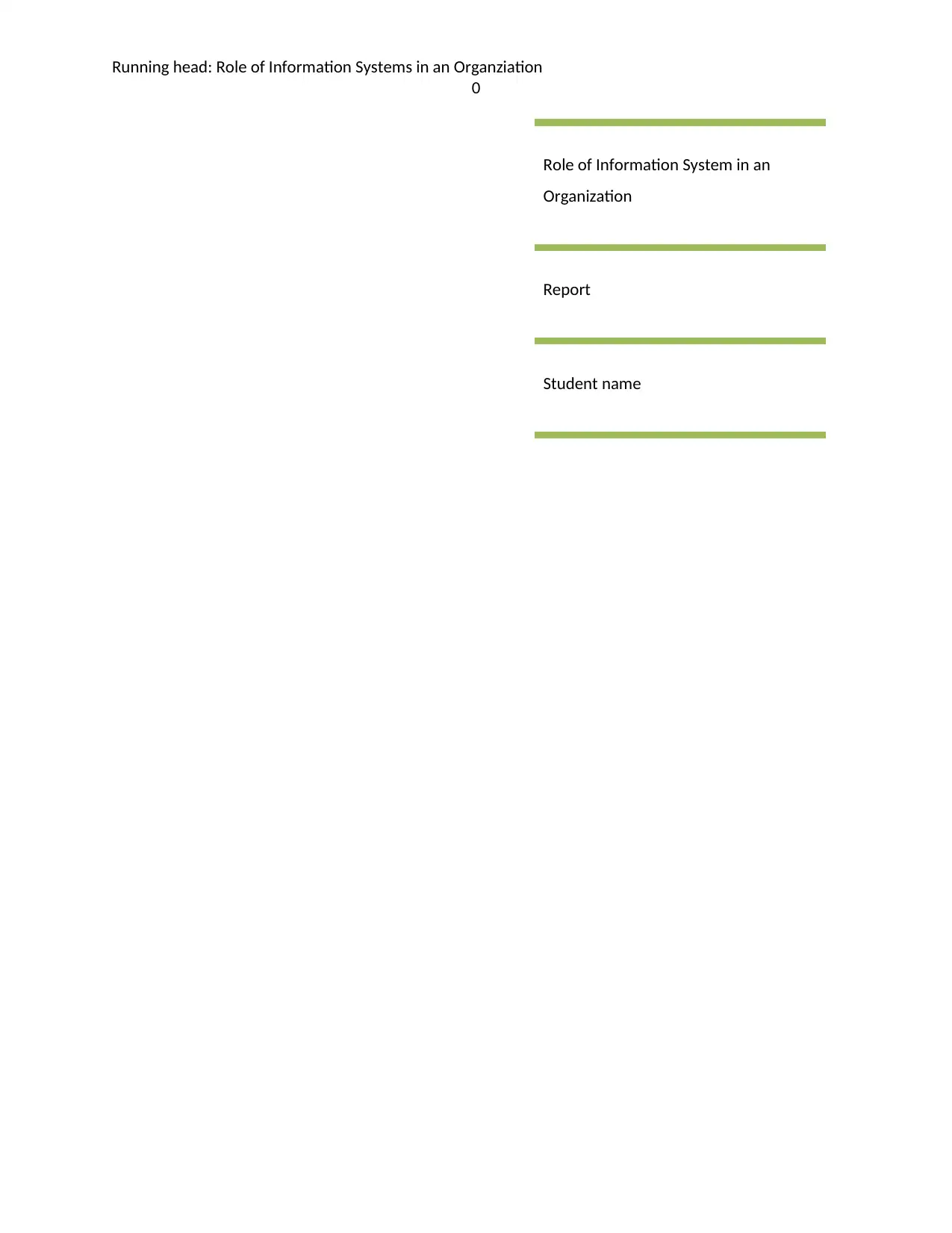
Running head: Role of Information Systems in an Organziation
0
Role of Information System in an
Organization
Report
Student name
0
Role of Information System in an
Organization
Report
Student name
Paraphrase This Document
Need a fresh take? Get an instant paraphrase of this document with our AI Paraphraser
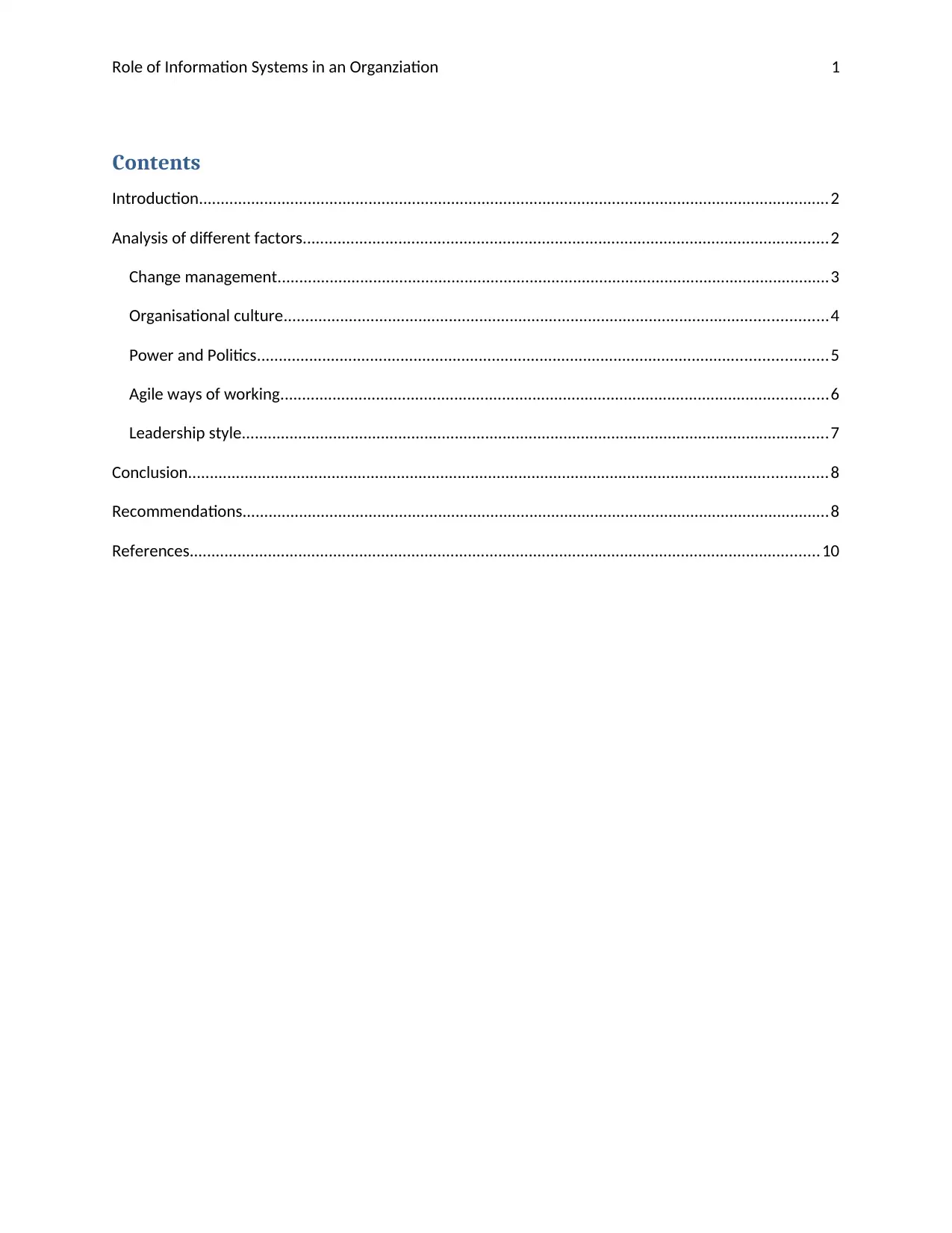
Role of Information Systems in an Organziation 1
Contents
Introduction.................................................................................................................................................2
Analysis of different factors.........................................................................................................................2
Change management...............................................................................................................................3
Organisational culture.............................................................................................................................4
Power and Politics...................................................................................................................................5
Agile ways of working..............................................................................................................................6
Leadership style.......................................................................................................................................7
Conclusion...................................................................................................................................................8
Recommendations.......................................................................................................................................8
References.................................................................................................................................................10
Contents
Introduction.................................................................................................................................................2
Analysis of different factors.........................................................................................................................2
Change management...............................................................................................................................3
Organisational culture.............................................................................................................................4
Power and Politics...................................................................................................................................5
Agile ways of working..............................................................................................................................6
Leadership style.......................................................................................................................................7
Conclusion...................................................................................................................................................8
Recommendations.......................................................................................................................................8
References.................................................................................................................................................10
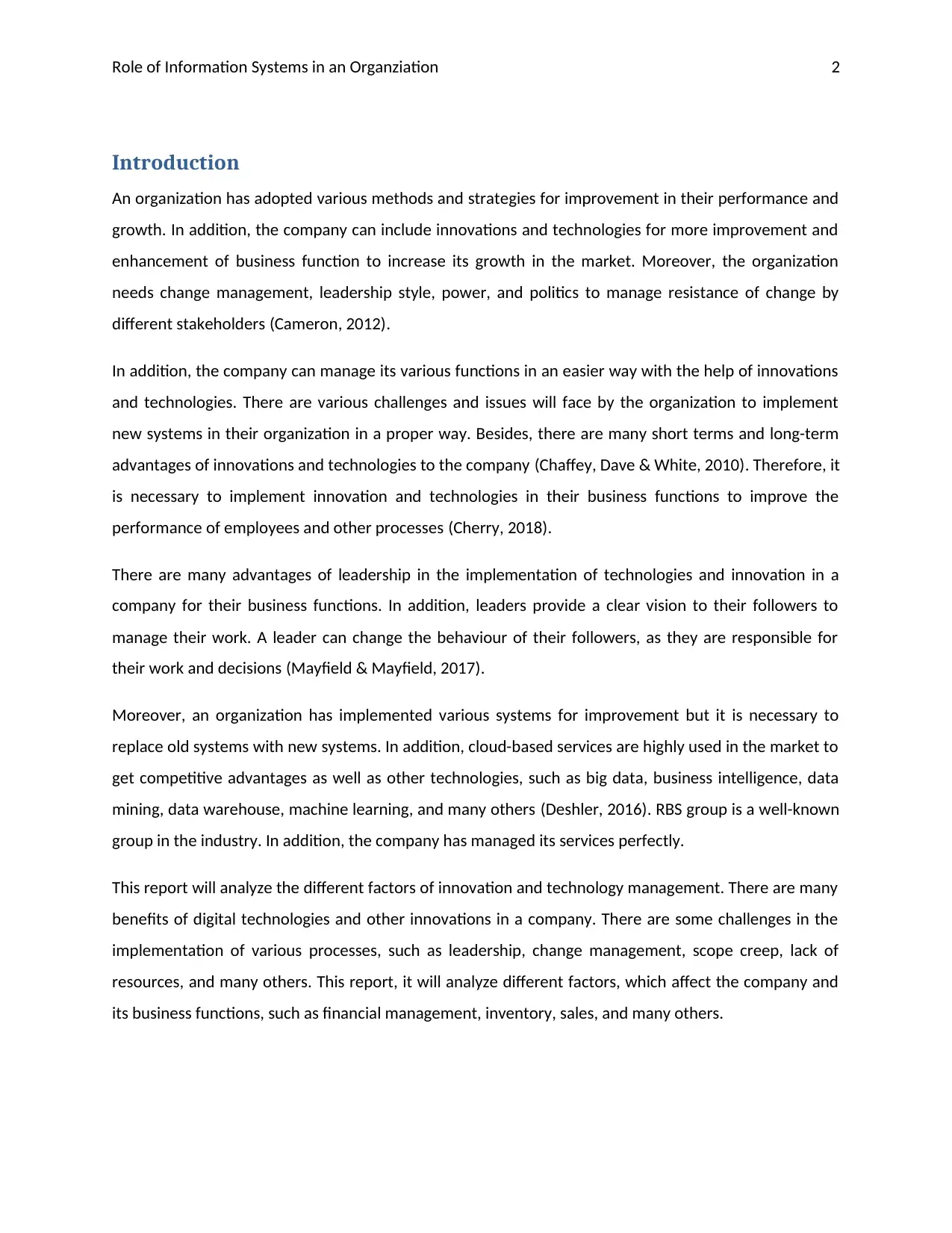
Role of Information Systems in an Organziation 2
Introduction
An organization has adopted various methods and strategies for improvement in their performance and
growth. In addition, the company can include innovations and technologies for more improvement and
enhancement of business function to increase its growth in the market. Moreover, the organization
needs change management, leadership style, power, and politics to manage resistance of change by
different stakeholders (Cameron, 2012).
In addition, the company can manage its various functions in an easier way with the help of innovations
and technologies. There are various challenges and issues will face by the organization to implement
new systems in their organization in a proper way. Besides, there are many short terms and long-term
advantages of innovations and technologies to the company (Chaffey, Dave & White, 2010). Therefore, it
is necessary to implement innovation and technologies in their business functions to improve the
performance of employees and other processes (Cherry, 2018).
There are many advantages of leadership in the implementation of technologies and innovation in a
company for their business functions. In addition, leaders provide a clear vision to their followers to
manage their work. A leader can change the behaviour of their followers, as they are responsible for
their work and decisions (Mayfield & Mayfield, 2017).
Moreover, an organization has implemented various systems for improvement but it is necessary to
replace old systems with new systems. In addition, cloud-based services are highly used in the market to
get competitive advantages as well as other technologies, such as big data, business intelligence, data
mining, data warehouse, machine learning, and many others (Deshler, 2016). RBS group is a well-known
group in the industry. In addition, the company has managed its services perfectly.
This report will analyze the different factors of innovation and technology management. There are many
benefits of digital technologies and other innovations in a company. There are some challenges in the
implementation of various processes, such as leadership, change management, scope creep, lack of
resources, and many others. This report, it will analyze different factors, which affect the company and
its business functions, such as financial management, inventory, sales, and many others.
Introduction
An organization has adopted various methods and strategies for improvement in their performance and
growth. In addition, the company can include innovations and technologies for more improvement and
enhancement of business function to increase its growth in the market. Moreover, the organization
needs change management, leadership style, power, and politics to manage resistance of change by
different stakeholders (Cameron, 2012).
In addition, the company can manage its various functions in an easier way with the help of innovations
and technologies. There are various challenges and issues will face by the organization to implement
new systems in their organization in a proper way. Besides, there are many short terms and long-term
advantages of innovations and technologies to the company (Chaffey, Dave & White, 2010). Therefore, it
is necessary to implement innovation and technologies in their business functions to improve the
performance of employees and other processes (Cherry, 2018).
There are many advantages of leadership in the implementation of technologies and innovation in a
company for their business functions. In addition, leaders provide a clear vision to their followers to
manage their work. A leader can change the behaviour of their followers, as they are responsible for
their work and decisions (Mayfield & Mayfield, 2017).
Moreover, an organization has implemented various systems for improvement but it is necessary to
replace old systems with new systems. In addition, cloud-based services are highly used in the market to
get competitive advantages as well as other technologies, such as big data, business intelligence, data
mining, data warehouse, machine learning, and many others (Deshler, 2016). RBS group is a well-known
group in the industry. In addition, the company has managed its services perfectly.
This report will analyze the different factors of innovation and technology management. There are many
benefits of digital technologies and other innovations in a company. There are some challenges in the
implementation of various processes, such as leadership, change management, scope creep, lack of
resources, and many others. This report, it will analyze different factors, which affect the company and
its business functions, such as financial management, inventory, sales, and many others.
⊘ This is a preview!⊘
Do you want full access?
Subscribe today to unlock all pages.

Trusted by 1+ million students worldwide
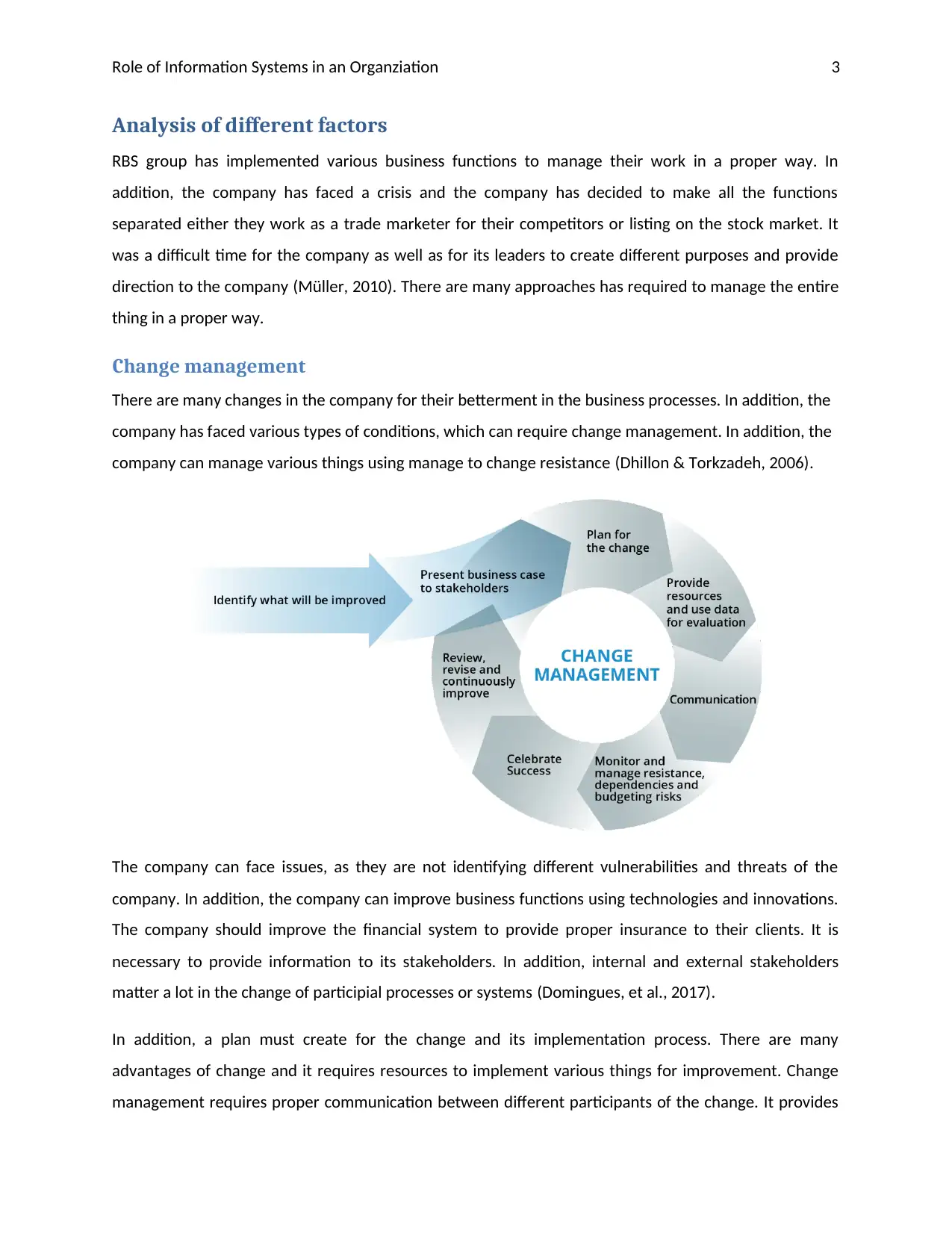
Role of Information Systems in an Organziation 3
Analysis of different factors
RBS group has implemented various business functions to manage their work in a proper way. In
addition, the company has faced a crisis and the company has decided to make all the functions
separated either they work as a trade marketer for their competitors or listing on the stock market. It
was a difficult time for the company as well as for its leaders to create different purposes and provide
direction to the company (Müller, 2010). There are many approaches has required to manage the entire
thing in a proper way.
Change management
There are many changes in the company for their betterment in the business processes. In addition, the
company has faced various types of conditions, which can require change management. In addition, the
company can manage various things using manage to change resistance (Dhillon & Torkzadeh, 2006).
The company can face issues, as they are not identifying different vulnerabilities and threats of the
company. In addition, the company can improve business functions using technologies and innovations.
The company should improve the financial system to provide proper insurance to their clients. It is
necessary to provide information to its stakeholders. In addition, internal and external stakeholders
matter a lot in the change of participial processes or systems (Domingues, et al., 2017).
In addition, a plan must create for the change and its implementation process. There are many
advantages of change and it requires resources to implement various things for improvement. Change
management requires proper communication between different participants of the change. It provides
Analysis of different factors
RBS group has implemented various business functions to manage their work in a proper way. In
addition, the company has faced a crisis and the company has decided to make all the functions
separated either they work as a trade marketer for their competitors or listing on the stock market. It
was a difficult time for the company as well as for its leaders to create different purposes and provide
direction to the company (Müller, 2010). There are many approaches has required to manage the entire
thing in a proper way.
Change management
There are many changes in the company for their betterment in the business processes. In addition, the
company has faced various types of conditions, which can require change management. In addition, the
company can manage various things using manage to change resistance (Dhillon & Torkzadeh, 2006).
The company can face issues, as they are not identifying different vulnerabilities and threats of the
company. In addition, the company can improve business functions using technologies and innovations.
The company should improve the financial system to provide proper insurance to their clients. It is
necessary to provide information to its stakeholders. In addition, internal and external stakeholders
matter a lot in the change of participial processes or systems (Domingues, et al., 2017).
In addition, a plan must create for the change and its implementation process. There are many
advantages of change and it requires resources to implement various things for improvement. Change
management requires proper communication between different participants of the change. It provides
Paraphrase This Document
Need a fresh take? Get an instant paraphrase of this document with our AI Paraphraser
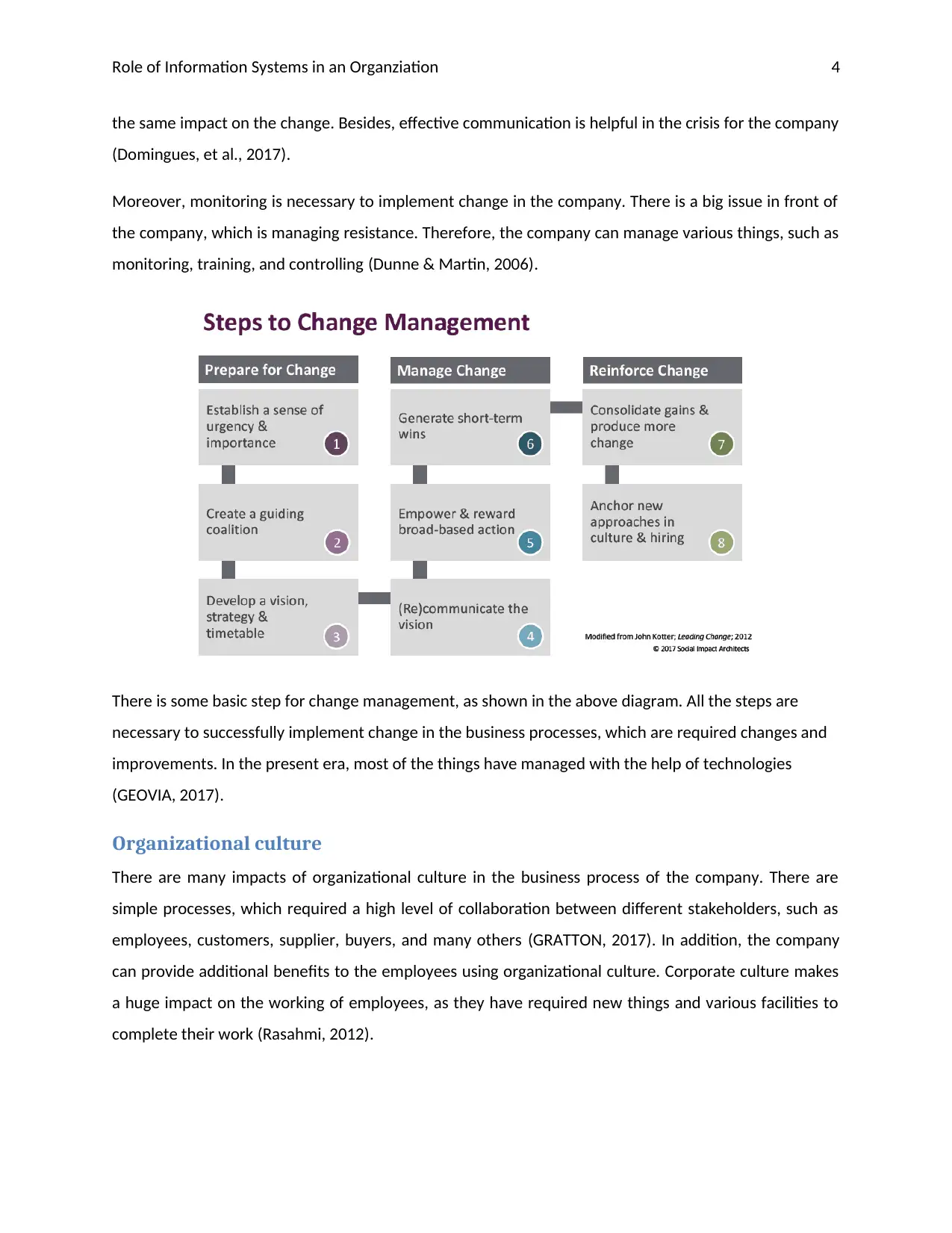
Role of Information Systems in an Organziation 4
the same impact on the change. Besides, effective communication is helpful in the crisis for the company
(Domingues, et al., 2017).
Moreover, monitoring is necessary to implement change in the company. There is a big issue in front of
the company, which is managing resistance. Therefore, the company can manage various things, such as
monitoring, training, and controlling (Dunne & Martin, 2006).
There is some basic step for change management, as shown in the above diagram. All the steps are
necessary to successfully implement change in the business processes, which are required changes and
improvements. In the present era, most of the things have managed with the help of technologies
(GEOVIA, 2017).
Organizational culture
There are many impacts of organizational culture in the business process of the company. There are
simple processes, which required a high level of collaboration between different stakeholders, such as
employees, customers, supplier, buyers, and many others (GRATTON, 2017). In addition, the company
can provide additional benefits to the employees using organizational culture. Corporate culture makes
a huge impact on the working of employees, as they have required new things and various facilities to
complete their work (Rasahmi, 2012).
the same impact on the change. Besides, effective communication is helpful in the crisis for the company
(Domingues, et al., 2017).
Moreover, monitoring is necessary to implement change in the company. There is a big issue in front of
the company, which is managing resistance. Therefore, the company can manage various things, such as
monitoring, training, and controlling (Dunne & Martin, 2006).
There is some basic step for change management, as shown in the above diagram. All the steps are
necessary to successfully implement change in the business processes, which are required changes and
improvements. In the present era, most of the things have managed with the help of technologies
(GEOVIA, 2017).
Organizational culture
There are many impacts of organizational culture in the business process of the company. There are
simple processes, which required a high level of collaboration between different stakeholders, such as
employees, customers, supplier, buyers, and many others (GRATTON, 2017). In addition, the company
can provide additional benefits to the employees using organizational culture. Corporate culture makes
a huge impact on the working of employees, as they have required new things and various facilities to
complete their work (Rasahmi, 2012).
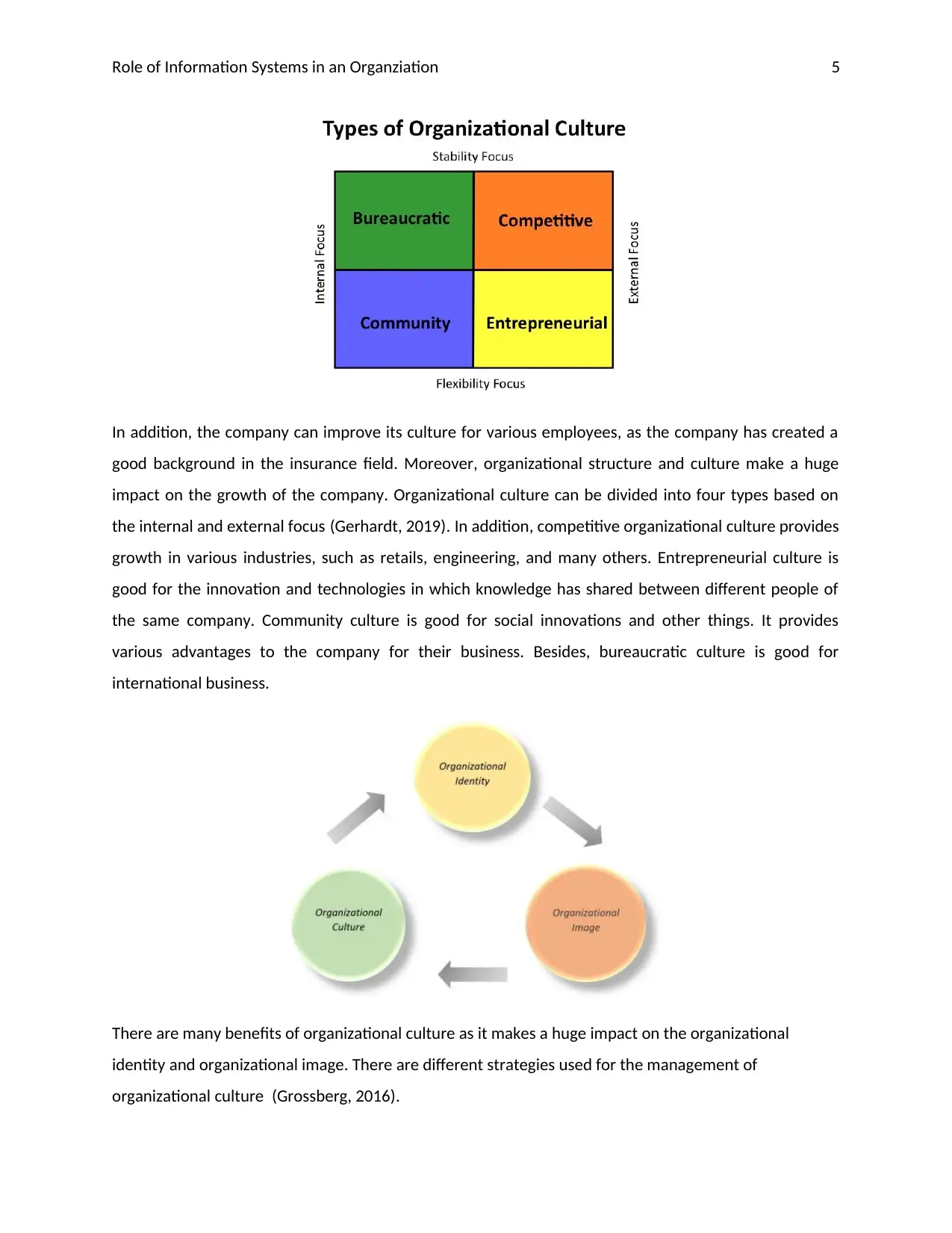
Role of Information Systems in an Organziation 5
In addition, the company can improve its culture for various employees, as the company has created a
good background in the insurance field. Moreover, organizational structure and culture make a huge
impact on the growth of the company. Organizational culture can be divided into four types based on
the internal and external focus (Gerhardt, 2019). In addition, competitive organizational culture provides
growth in various industries, such as retails, engineering, and many others. Entrepreneurial culture is
good for the innovation and technologies in which knowledge has shared between different people of
the same company. Community culture is good for social innovations and other things. It provides
various advantages to the company for their business. Besides, bureaucratic culture is good for
international business.
There are many benefits of organizational culture as it makes a huge impact on the organizational
identity and organizational image. There are different strategies used for the management of
organizational culture (Grossberg, 2016).
In addition, the company can improve its culture for various employees, as the company has created a
good background in the insurance field. Moreover, organizational structure and culture make a huge
impact on the growth of the company. Organizational culture can be divided into four types based on
the internal and external focus (Gerhardt, 2019). In addition, competitive organizational culture provides
growth in various industries, such as retails, engineering, and many others. Entrepreneurial culture is
good for the innovation and technologies in which knowledge has shared between different people of
the same company. Community culture is good for social innovations and other things. It provides
various advantages to the company for their business. Besides, bureaucratic culture is good for
international business.
There are many benefits of organizational culture as it makes a huge impact on the organizational
identity and organizational image. There are different strategies used for the management of
organizational culture (Grossberg, 2016).
⊘ This is a preview!⊘
Do you want full access?
Subscribe today to unlock all pages.

Trusted by 1+ million students worldwide
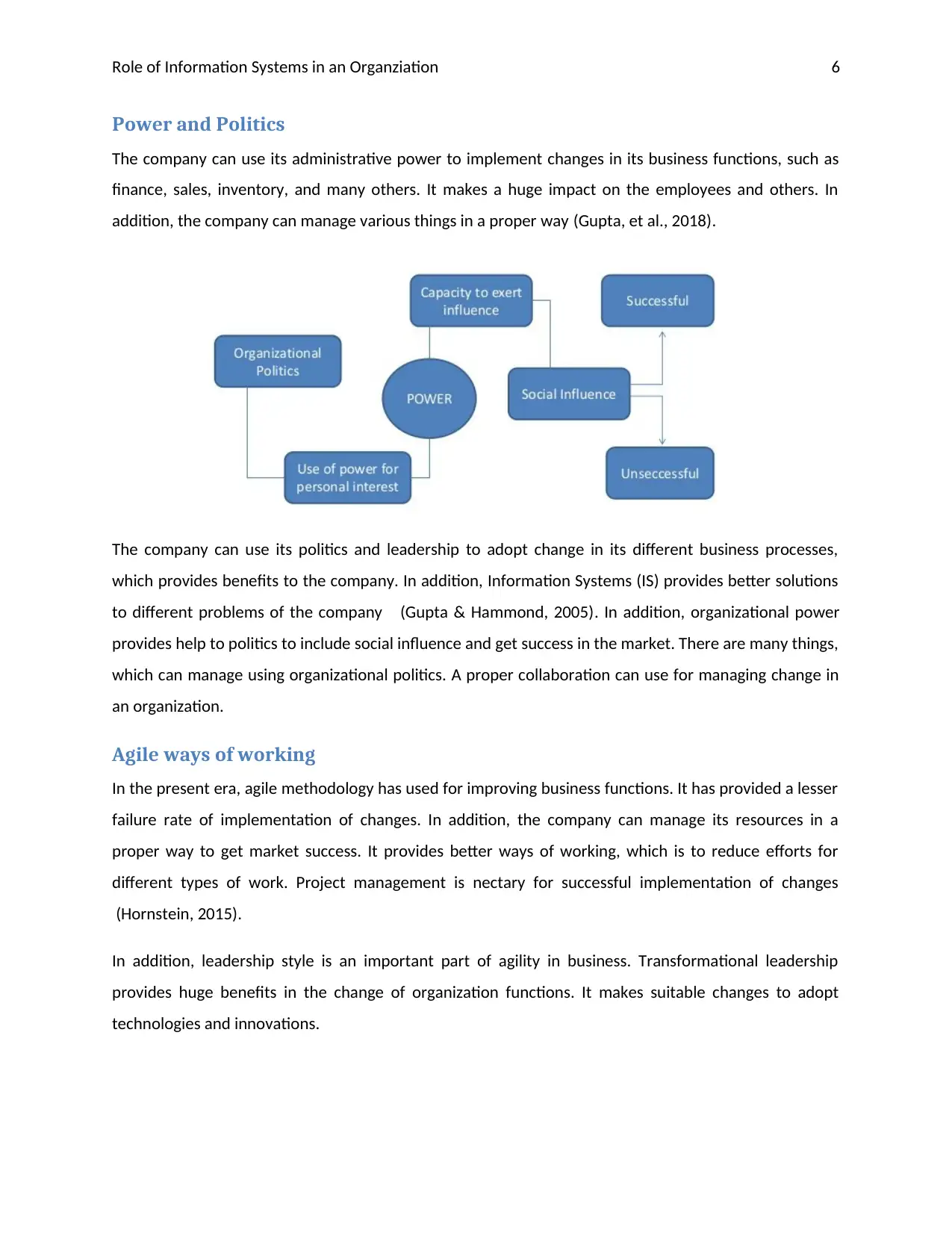
Role of Information Systems in an Organziation 6
Power and Politics
The company can use its administrative power to implement changes in its business functions, such as
finance, sales, inventory, and many others. It makes a huge impact on the employees and others. In
addition, the company can manage various things in a proper way (Gupta, et al., 2018).
The company can use its politics and leadership to adopt change in its different business processes,
which provides benefits to the company. In addition, Information Systems (IS) provides better solutions
to different problems of the company (Gupta & Hammond, 2005). In addition, organizational power
provides help to politics to include social influence and get success in the market. There are many things,
which can manage using organizational politics. A proper collaboration can use for managing change in
an organization.
Agile ways of working
In the present era, agile methodology has used for improving business functions. It has provided a lesser
failure rate of implementation of changes. In addition, the company can manage its resources in a
proper way to get market success. It provides better ways of working, which is to reduce efforts for
different types of work. Project management is nectary for successful implementation of changes
(Hornstein, 2015).
In addition, leadership style is an important part of agility in business. Transformational leadership
provides huge benefits in the change of organization functions. It makes suitable changes to adopt
technologies and innovations.
Power and Politics
The company can use its administrative power to implement changes in its business functions, such as
finance, sales, inventory, and many others. It makes a huge impact on the employees and others. In
addition, the company can manage various things in a proper way (Gupta, et al., 2018).
The company can use its politics and leadership to adopt change in its different business processes,
which provides benefits to the company. In addition, Information Systems (IS) provides better solutions
to different problems of the company (Gupta & Hammond, 2005). In addition, organizational power
provides help to politics to include social influence and get success in the market. There are many things,
which can manage using organizational politics. A proper collaboration can use for managing change in
an organization.
Agile ways of working
In the present era, agile methodology has used for improving business functions. It has provided a lesser
failure rate of implementation of changes. In addition, the company can manage its resources in a
proper way to get market success. It provides better ways of working, which is to reduce efforts for
different types of work. Project management is nectary for successful implementation of changes
(Hornstein, 2015).
In addition, leadership style is an important part of agility in business. Transformational leadership
provides huge benefits in the change of organization functions. It makes suitable changes to adopt
technologies and innovations.
Paraphrase This Document
Need a fresh take? Get an instant paraphrase of this document with our AI Paraphraser
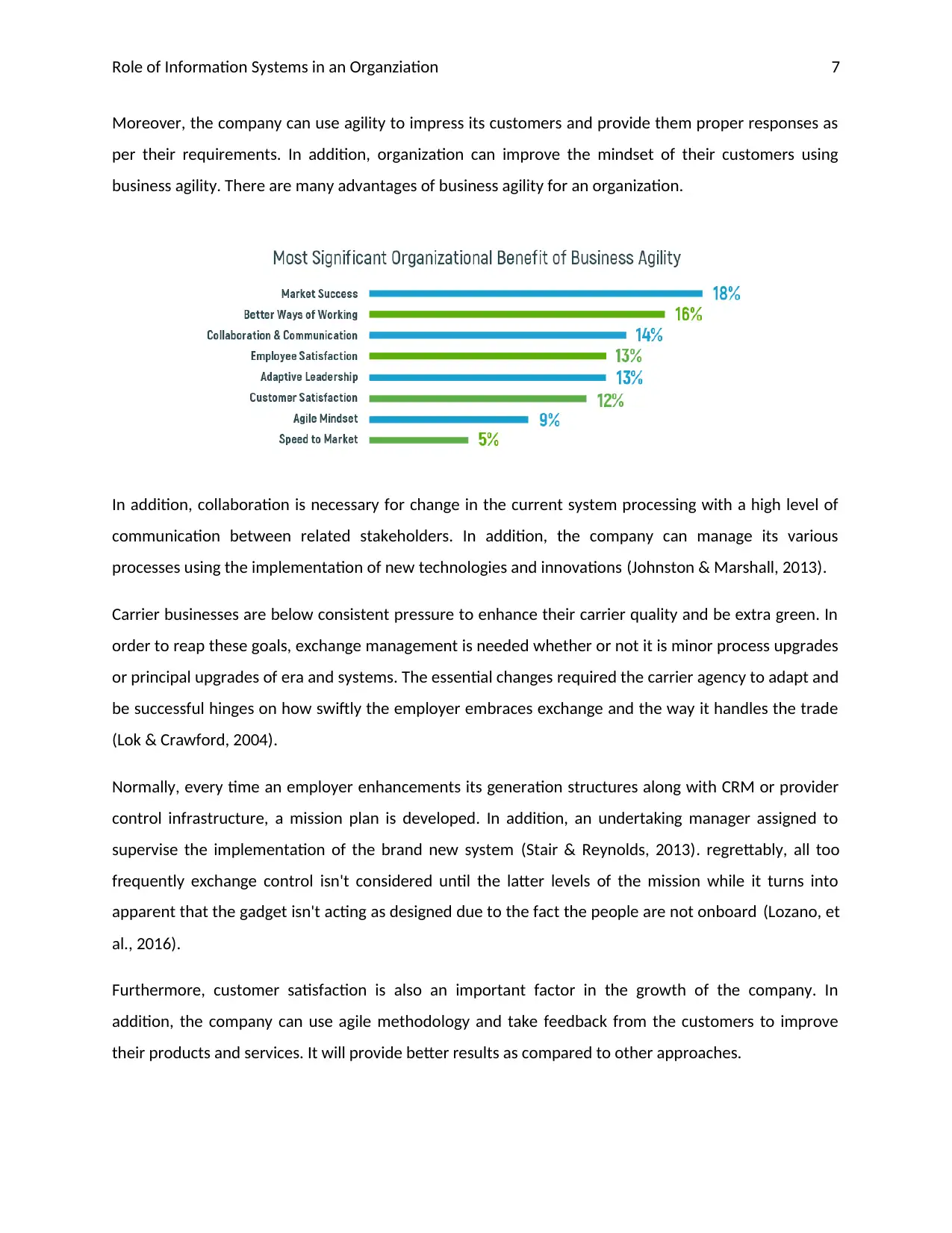
Role of Information Systems in an Organziation 7
Moreover, the company can use agility to impress its customers and provide them proper responses as
per their requirements. In addition, organization can improve the mindset of their customers using
business agility. There are many advantages of business agility for an organization.
In addition, collaboration is necessary for change in the current system processing with a high level of
communication between related stakeholders. In addition, the company can manage its various
processes using the implementation of new technologies and innovations (Johnston & Marshall, 2013).
Carrier businesses are below consistent pressure to enhance their carrier quality and be extra green. In
order to reap these goals, exchange management is needed whether or not it is minor process upgrades
or principal upgrades of era and systems. The essential changes required the carrier agency to adapt and
be successful hinges on how swiftly the employer embraces exchange and the way it handles the trade
(Lok & Crawford, 2004).
Normally, every time an employer enhancements its generation structures along with CRM or provider
control infrastructure, a mission plan is developed. In addition, an undertaking manager assigned to
supervise the implementation of the brand new system (Stair & Reynolds, 2013). regrettably, all too
frequently exchange control isn't considered until the latter levels of the mission while it turns into
apparent that the gadget isn't acting as designed due to the fact the people are not onboard (Lozano, et
al., 2016).
Furthermore, customer satisfaction is also an important factor in the growth of the company. In
addition, the company can use agile methodology and take feedback from the customers to improve
their products and services. It will provide better results as compared to other approaches.
Moreover, the company can use agility to impress its customers and provide them proper responses as
per their requirements. In addition, organization can improve the mindset of their customers using
business agility. There are many advantages of business agility for an organization.
In addition, collaboration is necessary for change in the current system processing with a high level of
communication between related stakeholders. In addition, the company can manage its various
processes using the implementation of new technologies and innovations (Johnston & Marshall, 2013).
Carrier businesses are below consistent pressure to enhance their carrier quality and be extra green. In
order to reap these goals, exchange management is needed whether or not it is minor process upgrades
or principal upgrades of era and systems. The essential changes required the carrier agency to adapt and
be successful hinges on how swiftly the employer embraces exchange and the way it handles the trade
(Lok & Crawford, 2004).
Normally, every time an employer enhancements its generation structures along with CRM or provider
control infrastructure, a mission plan is developed. In addition, an undertaking manager assigned to
supervise the implementation of the brand new system (Stair & Reynolds, 2013). regrettably, all too
frequently exchange control isn't considered until the latter levels of the mission while it turns into
apparent that the gadget isn't acting as designed due to the fact the people are not onboard (Lozano, et
al., 2016).
Furthermore, customer satisfaction is also an important factor in the growth of the company. In
addition, the company can use agile methodology and take feedback from the customers to improve
their products and services. It will provide better results as compared to other approaches.
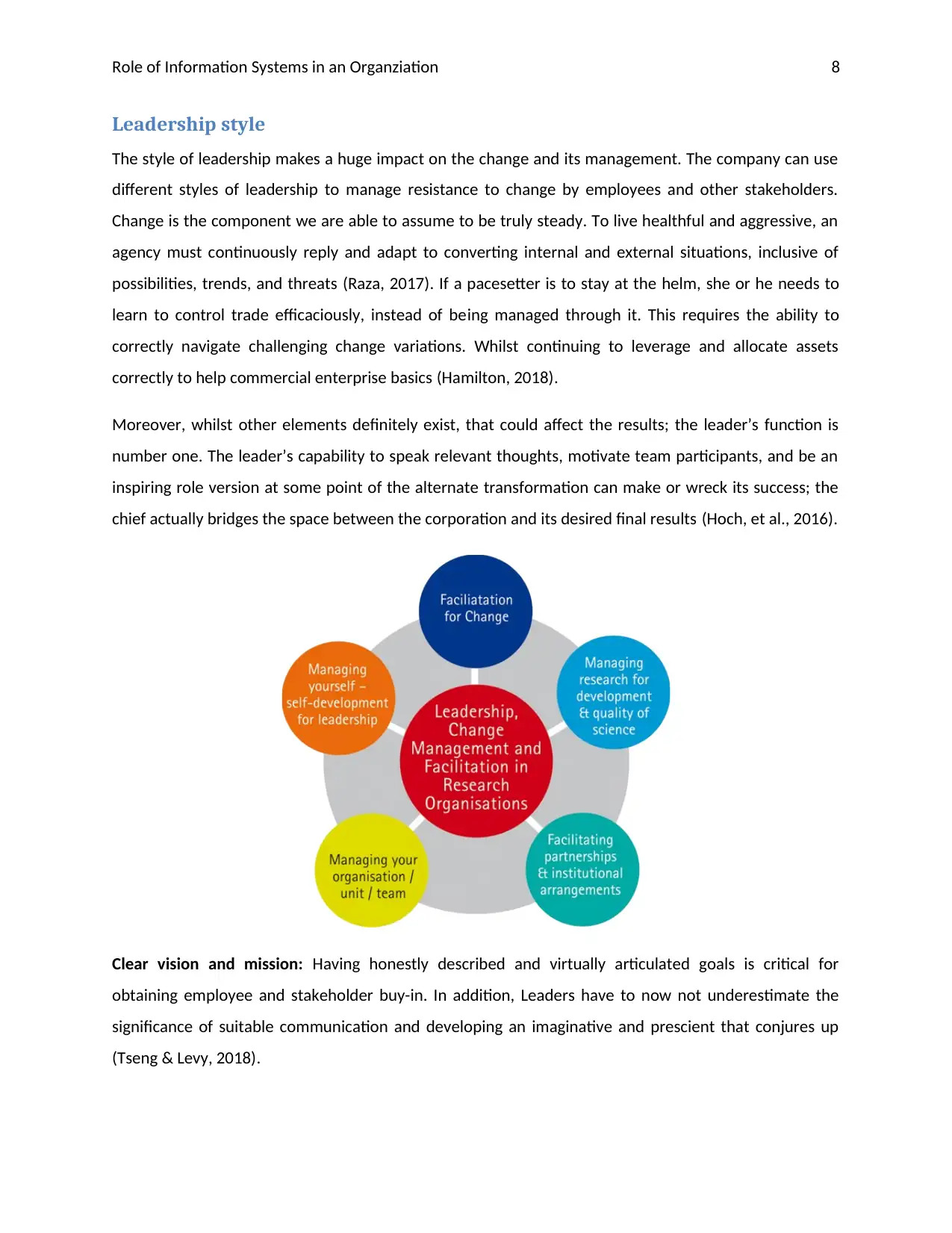
Role of Information Systems in an Organziation 8
Leadership style
The style of leadership makes a huge impact on the change and its management. The company can use
different styles of leadership to manage resistance to change by employees and other stakeholders.
Change is the component we are able to assume to be truly steady. To live healthful and aggressive, an
agency must continuously reply and adapt to converting internal and external situations, inclusive of
possibilities, trends, and threats (Raza, 2017). If a pacesetter is to stay at the helm, she or he needs to
learn to control trade efficaciously, instead of being managed through it. This requires the ability to
correctly navigate challenging change variations. Whilst continuing to leverage and allocate assets
correctly to help commercial enterprise basics (Hamilton, 2018).
Moreover, whilst other elements definitely exist, that could affect the results; the leader’s function is
number one. The leader’s capability to speak relevant thoughts, motivate team participants, and be an
inspiring role version at some point of the alternate transformation can make or wreck its success; the
chief actually bridges the space between the corporation and its desired final results (Hoch, et al., 2016).
Clear vision and mission: Having honestly described and virtually articulated goals is critical for
obtaining employee and stakeholder buy-in. In addition, Leaders have to now not underestimate the
significance of suitable communication and developing an imaginative and prescient that conjures up
(Tseng & Levy, 2018).
Leadership style
The style of leadership makes a huge impact on the change and its management. The company can use
different styles of leadership to manage resistance to change by employees and other stakeholders.
Change is the component we are able to assume to be truly steady. To live healthful and aggressive, an
agency must continuously reply and adapt to converting internal and external situations, inclusive of
possibilities, trends, and threats (Raza, 2017). If a pacesetter is to stay at the helm, she or he needs to
learn to control trade efficaciously, instead of being managed through it. This requires the ability to
correctly navigate challenging change variations. Whilst continuing to leverage and allocate assets
correctly to help commercial enterprise basics (Hamilton, 2018).
Moreover, whilst other elements definitely exist, that could affect the results; the leader’s function is
number one. The leader’s capability to speak relevant thoughts, motivate team participants, and be an
inspiring role version at some point of the alternate transformation can make or wreck its success; the
chief actually bridges the space between the corporation and its desired final results (Hoch, et al., 2016).
Clear vision and mission: Having honestly described and virtually articulated goals is critical for
obtaining employee and stakeholder buy-in. In addition, Leaders have to now not underestimate the
significance of suitable communication and developing an imaginative and prescient that conjures up
(Tseng & Levy, 2018).
⊘ This is a preview!⊘
Do you want full access?
Subscribe today to unlock all pages.

Trusted by 1+ million students worldwide
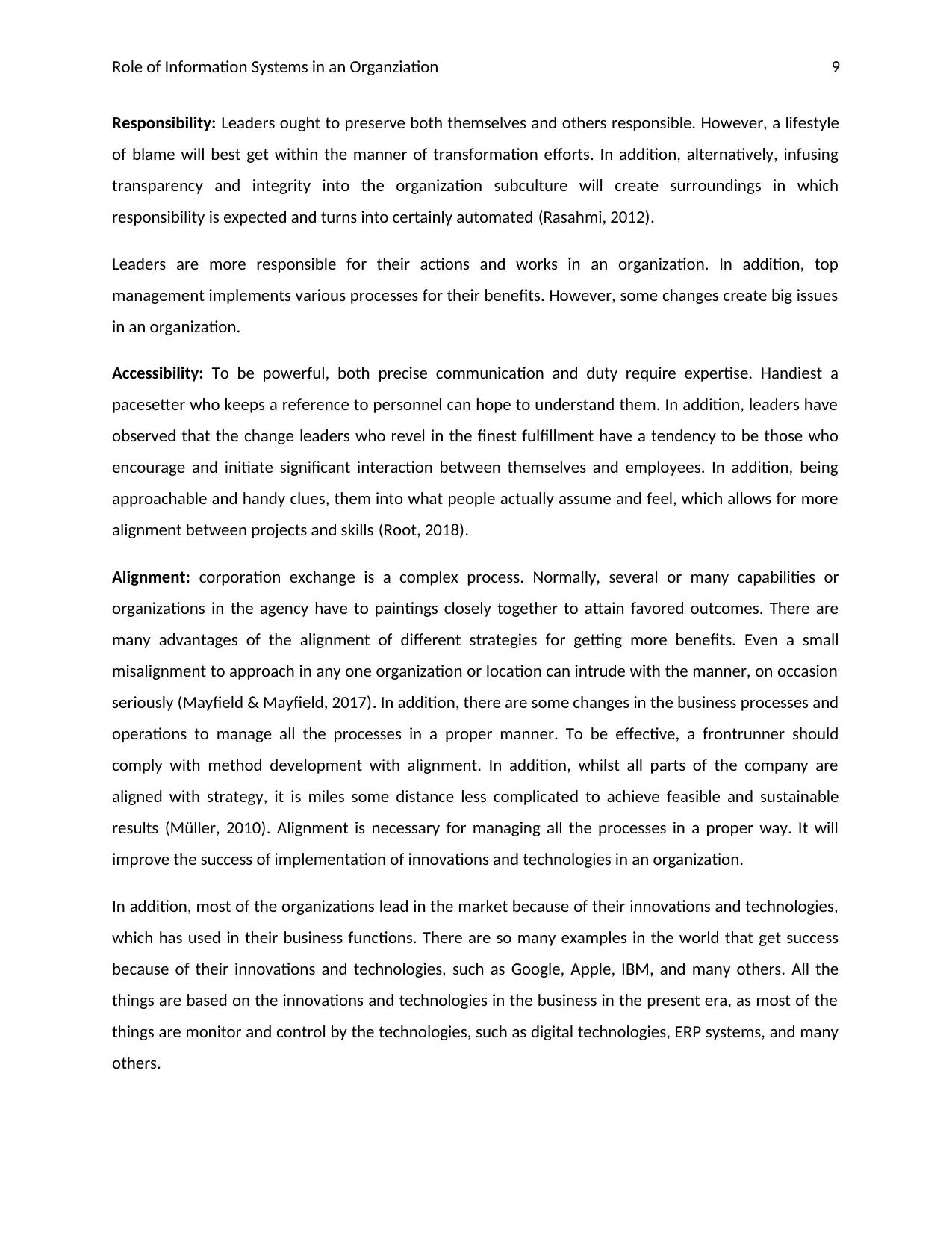
Role of Information Systems in an Organziation 9
Responsibility: Leaders ought to preserve both themselves and others responsible. However, a lifestyle
of blame will best get within the manner of transformation efforts. In addition, alternatively, infusing
transparency and integrity into the organization subculture will create surroundings in which
responsibility is expected and turns into certainly automated (Rasahmi, 2012).
Leaders are more responsible for their actions and works in an organization. In addition, top
management implements various processes for their benefits. However, some changes create big issues
in an organization.
Accessibility: To be powerful, both precise communication and duty require expertise. Handiest a
pacesetter who keeps a reference to personnel can hope to understand them. In addition, leaders have
observed that the change leaders who revel in the finest fulfillment have a tendency to be those who
encourage and initiate significant interaction between themselves and employees. In addition, being
approachable and handy clues, them into what people actually assume and feel, which allows for more
alignment between projects and skills (Root, 2018).
Alignment: corporation exchange is a complex process. Normally, several or many capabilities or
organizations in the agency have to paintings closely together to attain favored outcomes. There are
many advantages of the alignment of different strategies for getting more benefits. Even a small
misalignment to approach in any one organization or location can intrude with the manner, on occasion
seriously (Mayfield & Mayfield, 2017). In addition, there are some changes in the business processes and
operations to manage all the processes in a proper manner. To be effective, a frontrunner should
comply with method development with alignment. In addition, whilst all parts of the company are
aligned with strategy, it is miles some distance less complicated to achieve feasible and sustainable
results (Müller, 2010). Alignment is necessary for managing all the processes in a proper way. It will
improve the success of implementation of innovations and technologies in an organization.
In addition, most of the organizations lead in the market because of their innovations and technologies,
which has used in their business functions. There are so many examples in the world that get success
because of their innovations and technologies, such as Google, Apple, IBM, and many others. All the
things are based on the innovations and technologies in the business in the present era, as most of the
things are monitor and control by the technologies, such as digital technologies, ERP systems, and many
others.
Responsibility: Leaders ought to preserve both themselves and others responsible. However, a lifestyle
of blame will best get within the manner of transformation efforts. In addition, alternatively, infusing
transparency and integrity into the organization subculture will create surroundings in which
responsibility is expected and turns into certainly automated (Rasahmi, 2012).
Leaders are more responsible for their actions and works in an organization. In addition, top
management implements various processes for their benefits. However, some changes create big issues
in an organization.
Accessibility: To be powerful, both precise communication and duty require expertise. Handiest a
pacesetter who keeps a reference to personnel can hope to understand them. In addition, leaders have
observed that the change leaders who revel in the finest fulfillment have a tendency to be those who
encourage and initiate significant interaction between themselves and employees. In addition, being
approachable and handy clues, them into what people actually assume and feel, which allows for more
alignment between projects and skills (Root, 2018).
Alignment: corporation exchange is a complex process. Normally, several or many capabilities or
organizations in the agency have to paintings closely together to attain favored outcomes. There are
many advantages of the alignment of different strategies for getting more benefits. Even a small
misalignment to approach in any one organization or location can intrude with the manner, on occasion
seriously (Mayfield & Mayfield, 2017). In addition, there are some changes in the business processes and
operations to manage all the processes in a proper manner. To be effective, a frontrunner should
comply with method development with alignment. In addition, whilst all parts of the company are
aligned with strategy, it is miles some distance less complicated to achieve feasible and sustainable
results (Müller, 2010). Alignment is necessary for managing all the processes in a proper way. It will
improve the success of implementation of innovations and technologies in an organization.
In addition, most of the organizations lead in the market because of their innovations and technologies,
which has used in their business functions. There are so many examples in the world that get success
because of their innovations and technologies, such as Google, Apple, IBM, and many others. All the
things are based on the innovations and technologies in the business in the present era, as most of the
things are monitor and control by the technologies, such as digital technologies, ERP systems, and many
others.
Paraphrase This Document
Need a fresh take? Get an instant paraphrase of this document with our AI Paraphraser
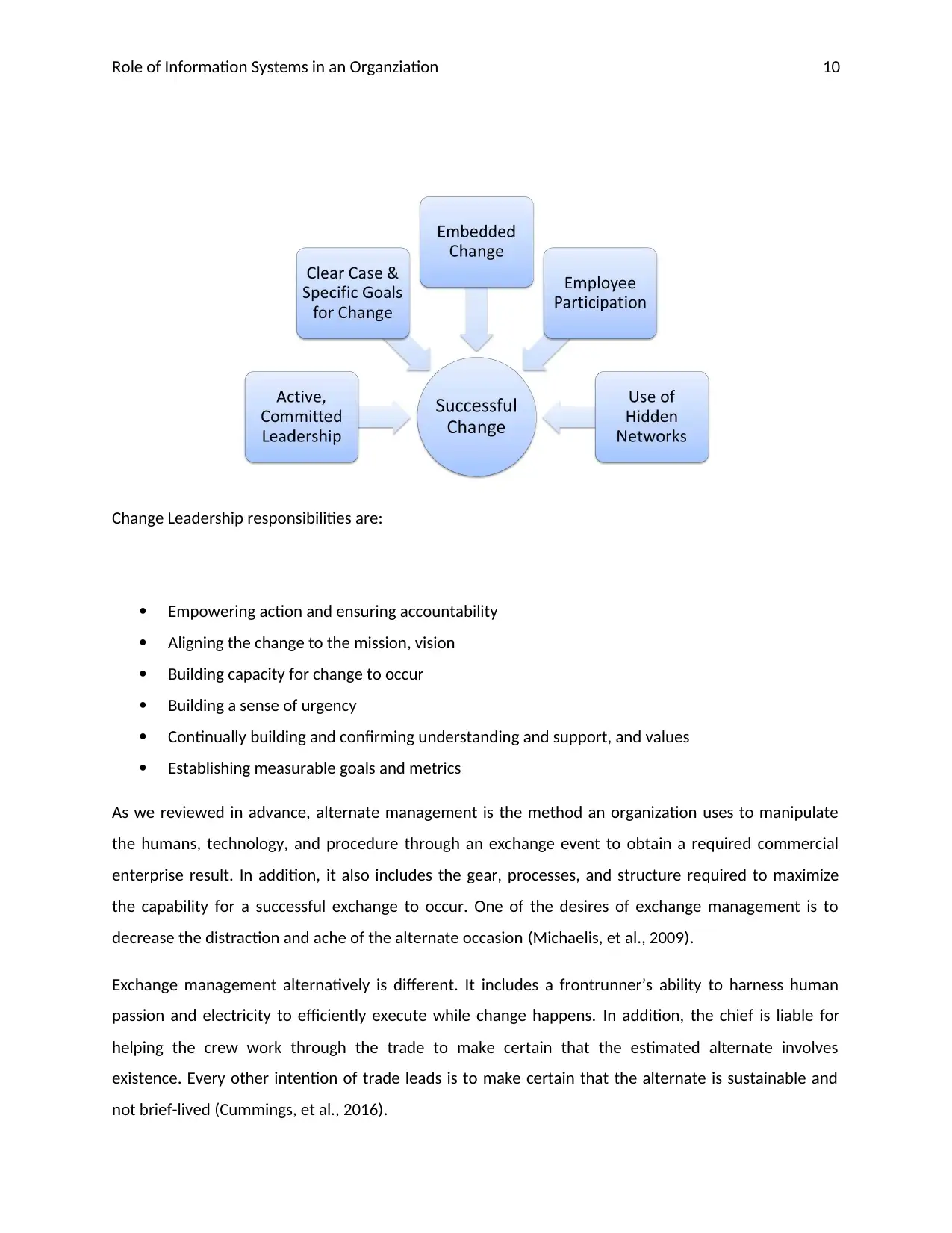
Role of Information Systems in an Organziation 10
Change Leadership responsibilities are:
Empowering action and ensuring accountability
Aligning the change to the mission, vision
Building capacity for change to occur
Building a sense of urgency
Continually building and confirming understanding and support, and values
Establishing measurable goals and metrics
As we reviewed in advance, alternate management is the method an organization uses to manipulate
the humans, technology, and procedure through an exchange event to obtain a required commercial
enterprise result. In addition, it also includes the gear, processes, and structure required to maximize
the capability for a successful exchange to occur. One of the desires of exchange management is to
decrease the distraction and ache of the alternate occasion (Michaelis, et al., 2009).
Exchange management alternatively is different. It includes a frontrunner’s ability to harness human
passion and electricity to efficiently execute while change happens. In addition, the chief is liable for
helping the crew work through the trade to make certain that the estimated alternate involves
existence. Every other intention of trade leads is to make certain that the alternate is sustainable and
not brief-lived (Cummings, et al., 2016).
Change Leadership responsibilities are:
Empowering action and ensuring accountability
Aligning the change to the mission, vision
Building capacity for change to occur
Building a sense of urgency
Continually building and confirming understanding and support, and values
Establishing measurable goals and metrics
As we reviewed in advance, alternate management is the method an organization uses to manipulate
the humans, technology, and procedure through an exchange event to obtain a required commercial
enterprise result. In addition, it also includes the gear, processes, and structure required to maximize
the capability for a successful exchange to occur. One of the desires of exchange management is to
decrease the distraction and ache of the alternate occasion (Michaelis, et al., 2009).
Exchange management alternatively is different. It includes a frontrunner’s ability to harness human
passion and electricity to efficiently execute while change happens. In addition, the chief is liable for
helping the crew work through the trade to make certain that the estimated alternate involves
existence. Every other intention of trade leads is to make certain that the alternate is sustainable and
not brief-lived (Cummings, et al., 2016).
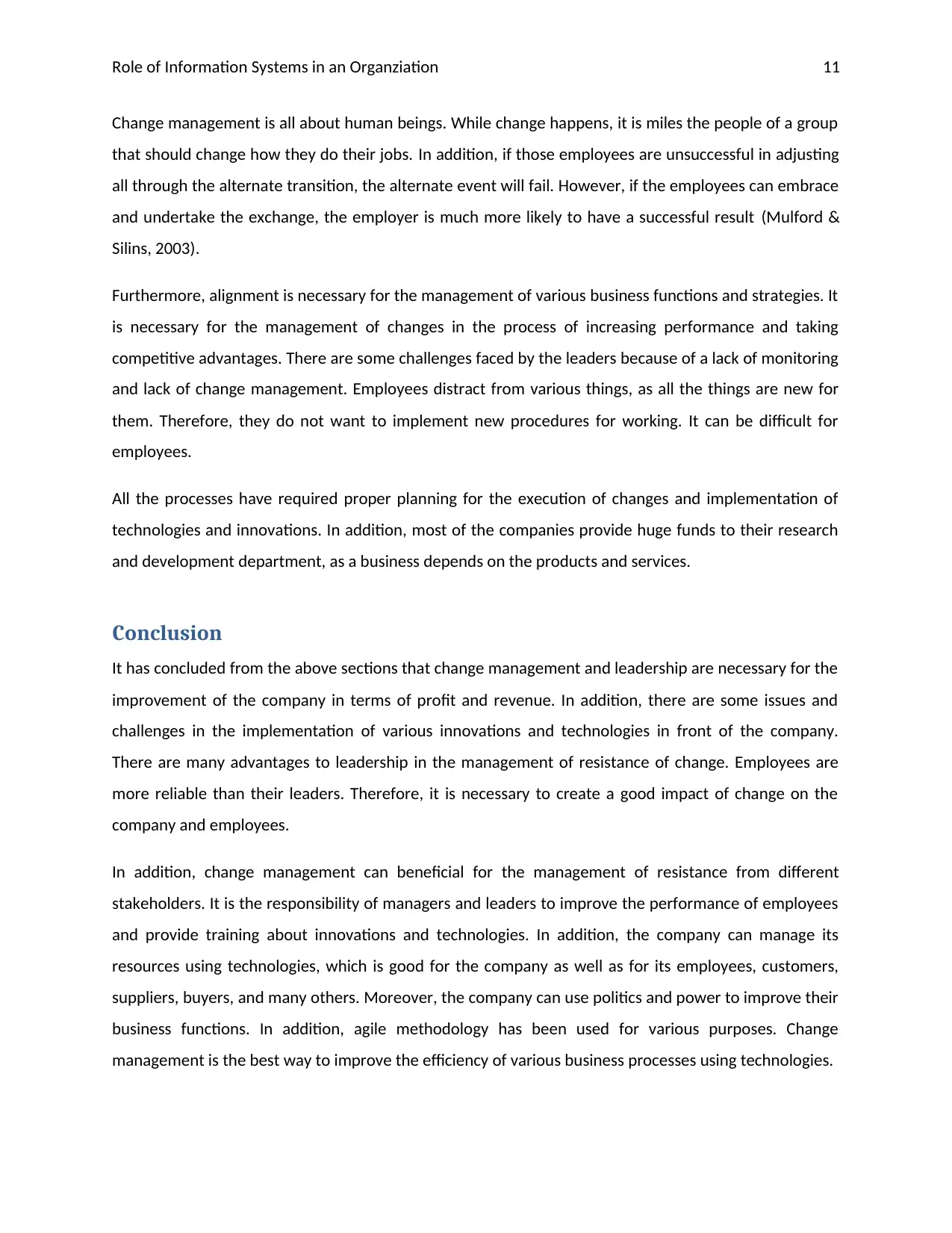
Role of Information Systems in an Organziation 11
Change management is all about human beings. While change happens, it is miles the people of a group
that should change how they do their jobs. In addition, if those employees are unsuccessful in adjusting
all through the alternate transition, the alternate event will fail. However, if the employees can embrace
and undertake the exchange, the employer is much more likely to have a successful result (Mulford &
Silins, 2003).
Furthermore, alignment is necessary for the management of various business functions and strategies. It
is necessary for the management of changes in the process of increasing performance and taking
competitive advantages. There are some challenges faced by the leaders because of a lack of monitoring
and lack of change management. Employees distract from various things, as all the things are new for
them. Therefore, they do not want to implement new procedures for working. It can be difficult for
employees.
All the processes have required proper planning for the execution of changes and implementation of
technologies and innovations. In addition, most of the companies provide huge funds to their research
and development department, as a business depends on the products and services.
Conclusion
It has concluded from the above sections that change management and leadership are necessary for the
improvement of the company in terms of profit and revenue. In addition, there are some issues and
challenges in the implementation of various innovations and technologies in front of the company.
There are many advantages to leadership in the management of resistance of change. Employees are
more reliable than their leaders. Therefore, it is necessary to create a good impact of change on the
company and employees.
In addition, change management can beneficial for the management of resistance from different
stakeholders. It is the responsibility of managers and leaders to improve the performance of employees
and provide training about innovations and technologies. In addition, the company can manage its
resources using technologies, which is good for the company as well as for its employees, customers,
suppliers, buyers, and many others. Moreover, the company can use politics and power to improve their
business functions. In addition, agile methodology has been used for various purposes. Change
management is the best way to improve the efficiency of various business processes using technologies.
Change management is all about human beings. While change happens, it is miles the people of a group
that should change how they do their jobs. In addition, if those employees are unsuccessful in adjusting
all through the alternate transition, the alternate event will fail. However, if the employees can embrace
and undertake the exchange, the employer is much more likely to have a successful result (Mulford &
Silins, 2003).
Furthermore, alignment is necessary for the management of various business functions and strategies. It
is necessary for the management of changes in the process of increasing performance and taking
competitive advantages. There are some challenges faced by the leaders because of a lack of monitoring
and lack of change management. Employees distract from various things, as all the things are new for
them. Therefore, they do not want to implement new procedures for working. It can be difficult for
employees.
All the processes have required proper planning for the execution of changes and implementation of
technologies and innovations. In addition, most of the companies provide huge funds to their research
and development department, as a business depends on the products and services.
Conclusion
It has concluded from the above sections that change management and leadership are necessary for the
improvement of the company in terms of profit and revenue. In addition, there are some issues and
challenges in the implementation of various innovations and technologies in front of the company.
There are many advantages to leadership in the management of resistance of change. Employees are
more reliable than their leaders. Therefore, it is necessary to create a good impact of change on the
company and employees.
In addition, change management can beneficial for the management of resistance from different
stakeholders. It is the responsibility of managers and leaders to improve the performance of employees
and provide training about innovations and technologies. In addition, the company can manage its
resources using technologies, which is good for the company as well as for its employees, customers,
suppliers, buyers, and many others. Moreover, the company can use politics and power to improve their
business functions. In addition, agile methodology has been used for various purposes. Change
management is the best way to improve the efficiency of various business processes using technologies.
⊘ This is a preview!⊘
Do you want full access?
Subscribe today to unlock all pages.

Trusted by 1+ million students worldwide
1 out of 18
Related Documents
Your All-in-One AI-Powered Toolkit for Academic Success.
+13062052269
info@desklib.com
Available 24*7 on WhatsApp / Email
![[object Object]](/_next/static/media/star-bottom.7253800d.svg)
Unlock your academic potential
Copyright © 2020–2025 A2Z Services. All Rights Reserved. Developed and managed by ZUCOL.





